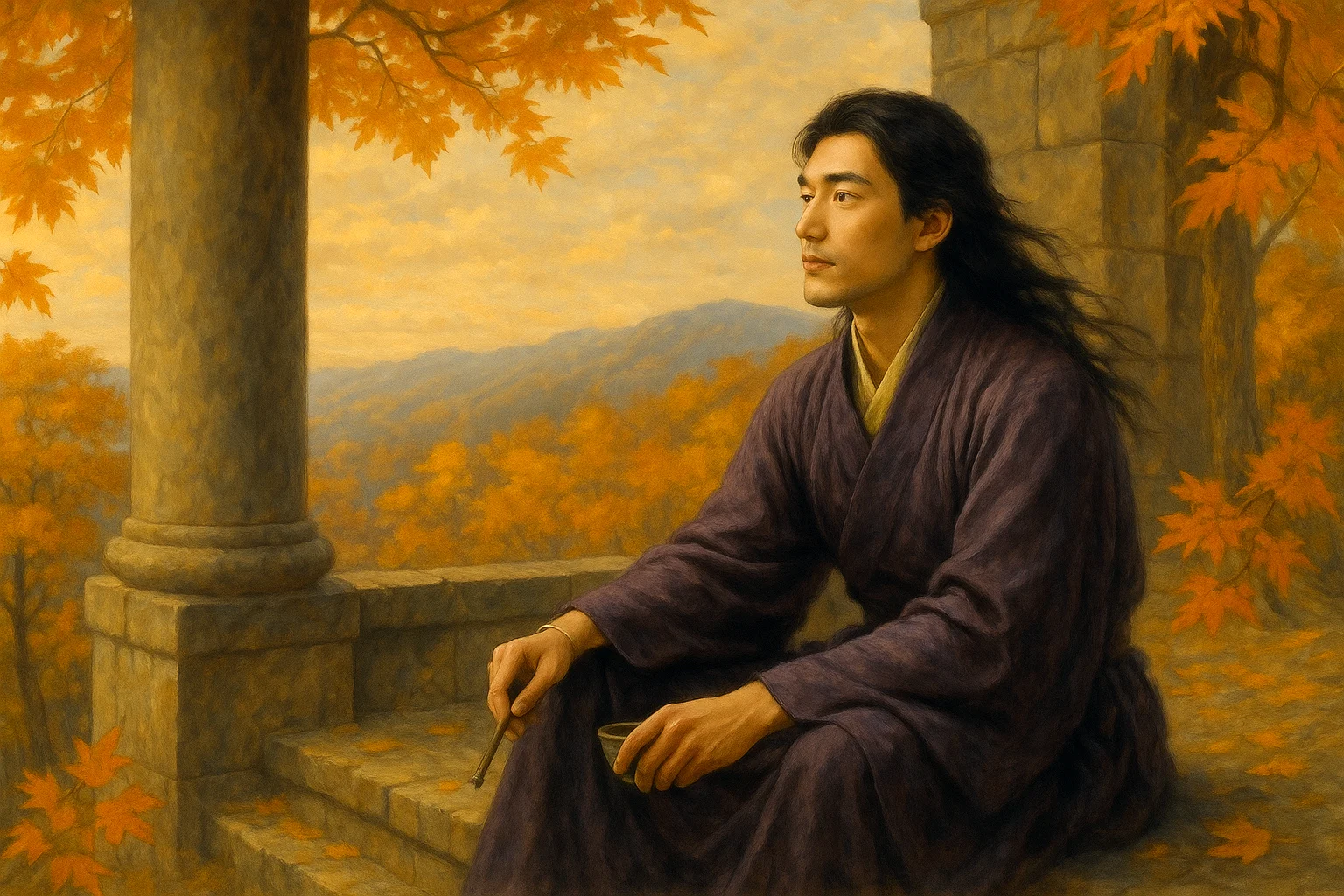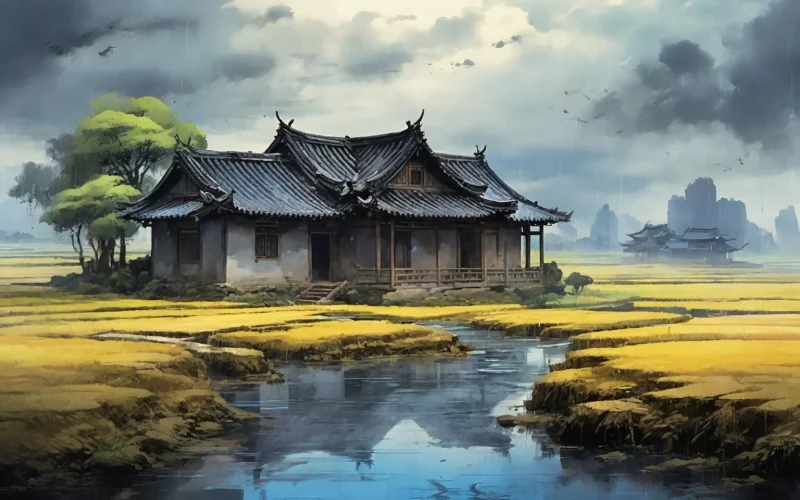Layered clouds loom dull and deep,
Silent rains in threads hang steep.
Floods drown ancient pathways bare,
Days of deluge swamp the lair.
When will crops be ripe to glean?
Few chimneys smoke in hamlets lean.
Torrents burst through gardens wide,
Rotting leaves on boughs abide.
Damp new firewood fuels dusk's fare,
Dawn's fishers shift their old haunt's lair.
Last year's chrysanthemums remain -
Lonely blooms by eastern fence plain.
Original Poem
「「秋中雨田园即事」耿湋」
耿玮
漠漠重云暗,萧萧密雨垂。
为霖淹古道,积日满荒陂。
五稼何时获,孤村几户炊。
乱流发通圃,腐叶著秋枝。
暮爨新樵湿,晨渔旧浦移。
空馀去年菊,花发在东篱。
Interpretation
Likely composed during Geng Wei's retirement to rural life or travels, this poem captures the agricultural hardships caused by prolonged autumn rains. Tang poets often used pastoral themes to express their sentiments, and Geng Wei, as one of the "Ten Literary Masters of the Dali Era," excelled in quiet yet profound depictions of nature. Here, through the lens of relentless rains over village fields, he reflects on farming struggles and rural decline, blending scene, event, and emotion to reveal how Tang pastoral poetry extended its gaze toward real-world concerns.
First Couplet: "漠漠重云暗,萧萧密雨垂。"
Mò mò chóng yún àn, xiāo xiāo mì yǔ chuí.
Lead-heavy clouds smother the sky's last light,
While ceaseless rains whisper through the night.
The opening juxtaposes static gloom and dynamic rainfall to create oppressive atmosphere. "Lead-heavy" (漠漠) paints the sky's suffocating weight, while "whisper" (萧萧) mimics the rain's hushed patter—a sonic texture that lingers in the ear. The unrelenting descent of rain carries not autumn's romance but a season's protracted melancholy, establishing the poem's somber tone.
Second Couplet: "为霖淹古道,积日满荒陂。"
Wèi lín yān gǔ dào, jī rì mǎn huāng bēi.
These drowning rains flood ancient roads away,
And rise to claim the barren slopes day after day.
Here, the rains' devastation emerges. "Drowning" (淹) and "claim" (满) materialize the deluge's assault. By choosing "ancient roads" and "barren slopes"—sites resonant with time and emptiness—the poet maps both natural damage and social desolation, where hydrological disaster mirrors human withdrawal.
Third Couplet: "五稼何时获,孤村几户炊。"
Wǔ jià hé shí huò, gū cūn jǐ hù chuī.
When will the five crops ever be won?
How many hearths still burn in this lone village undone?
The focus shifts to agrarian and human toll. "Five crops" (五稼) symbolize unsecured harvests, while "how many hearths" (几户炊) lays bare the village's fading vitality. The rhetorical questions, though plainspoken, thrum with quiet alarm—a scholar-official's lament for the peasantry's fragile existence.
Fourth Couplet: "乱流发通圃,腐叶著秋枝。"
Luàn liú fā tōng pǔ, fǔ yè zhuó qiū zhī.
Torrents breach gardens, chaos their wake,
Rot clings to boughs that autumn won't take.
Chaos dominates this visceral tableau. "Breach" (发) depicts waterways run amok through cultivated plots, while "rot clings" (腐叶著) captures nature's morbid suspension—decay persisting unnaturally on branches. These images of violation and stubborn corruption mirror societal decline and life's tenuous hold.
Fifth Couplet: "暮爨新樵湿,晨渔旧浦移。"
Mù cuàn xīn qiáo shī, chén yú jiù pǔ yí.
Damp new-cut kindling chokes the evening fire,
Dawn fishermen find their coves swallowed by mire.
Daily adaptations to disaster unfold. "Damp kindling" (新樵湿) renders the struggle for basic warmth, while "coves swallowed" (旧浦移) shows how familiar fishing grounds vanish overnight. These granular details of laboring life—rare in Geng Wei's oeuvre—reveal his deepened social gaze during crisis.
Sixth Couplet: "空馀去年菊,花发在东篱。"
Kōng yú qù nián jú, huā fā zài dōng lí.
Only last year's chrysanthemums remain,
Blossoming still by the east fence, defiant of the rain.
The finale pivots to resilient beauty. Chrysanthemums—classic emblems of endurance—"defiant of the rain" (花发) offer a muted counterpoint to ruin. The "east fence" (东篱) quietly invokes Tao Qian's pastoral idealism, suggesting the poet's own moral steadfastness amid despair. This closing grace note tempers the poem's grief with quiet transcendence.
Holistic Appreciation
This is a quintessential pastoral realism poem that begins with incessant rainfall and systematically unfolds its cascading effects on rural life—farmwork, village routines, and the natural world—each layer meticulously connected to create vivid imagery and tangible realism. Rather than voicing discontent through lament, the poet employs straightforward depiction to portray everyday scenes: from "ancient paths submerged" to "a few chimneys smoking," then to "chrysanthemums by the eastern fence." The emotional tone shifts subtly from somber to quietly resilient, infusing the poem with enduring vitality. Geng Wei seamlessly merges pastoral themes with contemporary concerns, expressing both compassion for the people's hardships and reverence for nature's cycles.
Artistic Merits
- Clear Progression, Cohesive Structure: The six couplets progress from rain-soaked landscapes to human activities before returning to nature, forming a complete narrative loop.
- Unadorned Realism, Profound Depth: With plain yet potent language devoid of embellishment, the poem lays bare life's struggles and quiet hopes.
- Scene-Emotion Fusion, Layered Meaning: While ostensibly depicting rural trivialities, the work carries profound humanistic concern; though the autumn rain seems merciless, the resilient chrysanthemum emerges as a symbol of perseverance.
Insights
The poem teaches us that even in stormy times when all endeavors seem thwarted, one must cling to inner steadfastness and undimmed hope. The chrysanthemums blooming alone after the rain mirror humanity's capacity to retain dignity amid adversity. Through keen observation and restrained expression, Geng Wei reminds us: when facing both natural and societal turbulence, only grounded perseverance and an anchored spirit can guide us through.
About the poet

Geng Wei (耿湋, dates unknown), a Tang dynasty poet from Yongji, Shanxi, was among the "Ten Great Talents of the Dali Era." Renowned for his mastery of five-character regulated verse, his poetry is distinguished by its economical diction and tranquil imagery. While the prevailing style of Dali poetry tended toward austerity and desolation, Geng Wei developed a distinctive voice marked by understated naturalism.












